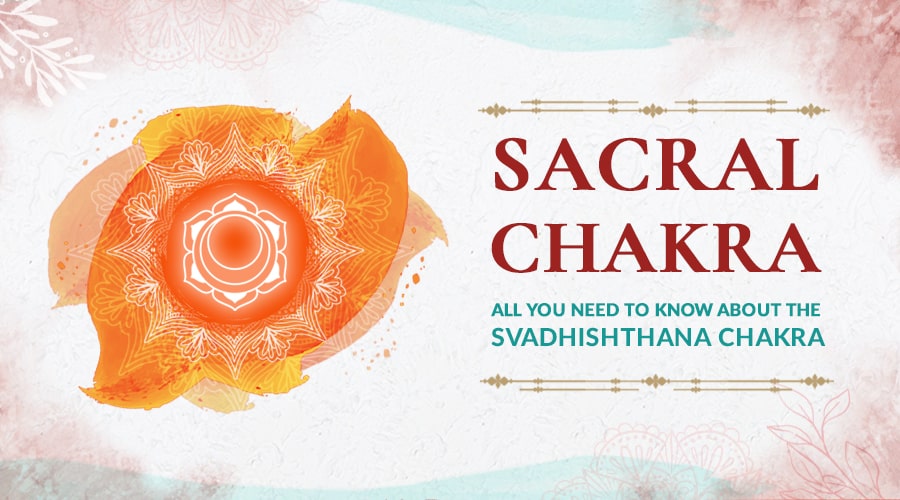Our bodies are constantly communicating with the energies surrounding us. Every chakra preserves and channels pranic energy (life-force energy) in our astral (energy) body, influencing the balance in our physical body. The Sacral Chakra, or Svadhishthana Chakra, is the second energy center among the 7 primary chakras. This chakra plays an important role in our well-being, awakening our creativity and sexual energy while maintaining the healthy functioning of our bladder, kidneys, and reproductive organs.
In this guide to the Sacral Chakra, we will explore the defining characteristics of the second energy center and important signs and symptoms to look out for. We will also show you how to heal and balance this chakra with powerful yogic tools like yoga poses, chakra meditation, and positive affirmations.
What Is the Sacral Chakra?
The Sacral Chakra is the second energy center in the body. It is the energy center for the vital force or prana ‘vyana,’ which is the energy of circulation. It is associated with the element of water and the vibrant color orange. This energy assists in letting go, accepting change, and transformation in life. It is also a direct line to our creativity, intuition, and sexual pleasure.
What Is the Meaning of the Sacral Chakra?
The Sanskrit name Svadhishthana means “dwelling place of the Self”, supporting the personal expansion and exploration of sexuality, desires, and creativity. It is called our own place because it is this chakra where human beings are settled in their minds, thoughts, and awareness.
Where Is the Sacral Chakra Located?
The Sacral Chakra is located in the lower abdomen, four fingerbreadths below the navel.
What Is the Sacral Chakra Responsible for?
The Sacral Chakra is responsible for the storage and distribution of vyana prana, and for maintaining the water element in the body. Due to its location, it is also closely associated with the bladder, kidneys, and reproductive organs, and helps regulate the flow of energy in this area of the body.
Sacral Chakra Characteristics
Symbol

The artistic symbol for the Svadhishthana Chakra consists of multiple circles, a crescent moon, and a lotus flower with six petals. The circles and crescent moon represent the cyclical nature of life, death, and rebirth, while the six petals symbolize the six negative aspects of our nature that we need to overcome to bring balance to our minds and body.
Element: Water
The element of the Sacral Chakra is ‘Jala’, meaning water. We get water from the food we eat and the liquids we drink. The Svadhishthana Chakra regulates the water element and helps to maintain and refresh it in our body.
It is very important to refresh the water element. For example, if you have a water bottle and refill it every day, you will always have a clean supply of water. But if you fill the bottle and leave it for a few weeks, the water can become contaminated and make you sick.
The water element governs our sense of joy and pleasure in life, and is associated with our sexuality, sensory desires, emotions, and creativity. When the element is getting refreshed it keeps our emotions and desires in balance, but when the element rots, we become addicted to sensory pleasures and controlled by our emotions.
Prana: Vyana
The prana associated with the second energy center is ‘vyana’. Vyana is the prana of circulation. We get it from the element water. Vyana is responsible for the circulation of food, water, and energy in our bodies. When we have too much vyana we feel hyperactive and unable to focus. When we have too little vyana, we feel lethargic and disconnected from our emotions.
Color: Orange
The Svadhishthana Chakra is surrounded by the water element. Even though the water element has no color of its own, the red of the earth element below and the yellow of the fire element above reflect onto the water to create a vermillion or orange color.
This vibrant color is symbolic of the rising consciousness just like a sunrise. Orange is also the color of activity and purity, and it is in this chakra that we design our life vision.
What Happens When the Sacral Chakra Opens?
The second chakra enables us to shape our desires. As the center of passion, it awakens the power of creation. This allows a person to discover the power of choice and create intimate relationships. Motivated by pleasure, Svadhishthana Chakra promotes emotional well-being. It plays an active role in our sexuality and the expression of our emotional needs and desires.
Emotional Intimacy, Relationships, and the Sacral Chakra
This chakra is centered on personal identity and how it responds to the seductive forces of the physical world. A person with an open and balanced Sacral Chakra has the ability to enjoy the senses with discipline and keep their emotions and relationships in balance.
When the second chakra is unbalanced, it causes emotional disturbances, reduced creativity, and an obsession with sexual thoughts. A person with an open and balanced Svadhishthana Chakra has the ability to take risks and experience positivity and compassion fully.
What Happens When the Sacral Chakra Is Blocked?
When the Sacral Chakra is blocked or imbalanced, it can make you feel emotionally unstable. You will either be too sensitive, or you will not be in touch with your emotions at all. You may be lacking creativity and discipline, as well as having an addiction to sensory pleasure.
Depression, anxiety, and the fear of losing control in a relationship are all signs that this energy center is blocked. It also affects our connection to various physical aspects of life like work.
Physical symptoms of an imbalanced Sacral Chakra:
- Chronic lower back pain
- Arthritis
- Genital or sexual problems
- Hip issues
- Anemia
- Joint problems
- Low energy
- Spleen and kidney issues
- Premenstrual Syndrome
- Sinusitis

Sign up for our newsletter and get exclusive access to a free guided meditation and lecture with master teacher Ram Jain.

Overactive Sacral Chakra Symptoms
An overactive Svadhishthana Chakra means that there is too much vyana being distributed throughout the body. Since the second chakra governs emotions, overactive energy creates overwhelming feelings and emotions, which can manifest as:
- Extreme mood swings
- Dissatisfaction with life
- Addictive behaviors
- Feeling disconnected from the world
- Intense displays of affection
- Uncontrollable sexual urges and sensory desires
Underactive Sacral Chakra Symptoms
An underactive energy center can affect your entire physical and mental well-being. When the Svadhishthana Chakra is blocked, feelings ranging from uncertainty to an inability to cope with life’s changes permeate. The path to freely express desires hinders artistic abilities and you may begin to depend on others emotionally, resulting in a psychological imbalance and detachment from the Self. Other symptoms include:
- Fear of pleasure
- Lack of creativity
- Fatigue
- Lack of desire
- Insecurity
- Detachment
- Low libido
- Depression
How to Unblock & Heal the Sacral Chakra
There are several simple ways to restore the balance of the chakras. Sacral Chakra healing brings a harmonious flow of energy throughout the body. This can be done through chakra meditation, yoga poses, and even mudras (hand gestures). Here are four easy and effective ways you can balance your second chakra:
Affirmations
Affirmations are a positive way to heal negative programming that can be embedded in the subconscious. Practicing affirmations can reprogram the subconscious with a positive mindset and raise energy vibrations. Use these Sacral Chakra affirmations to promote positive energy and balance in your life:
- I am passionate.
- I am a creative being.
- I have boundaries that protect me.
- I am fulfilled in my passions.
- I embrace change as a healthy part of life.
- I have an abundance of creativity.
- My emotions are in balance.
Meditation
Meditation plays a vital role in balancing and opening chakras. Chakra meditation techniques are very similar to general meditation techniques. The main difference is the focus and end goal of the practice. Practicing Sacral Chakra meditation regularly can help channel positive energy and thought patterns, boosting your creativity, joy, and confidence.
Sacral Chakra Yoga Poses for Energy Activation and Alignment
Crow Pose (Kakasana)
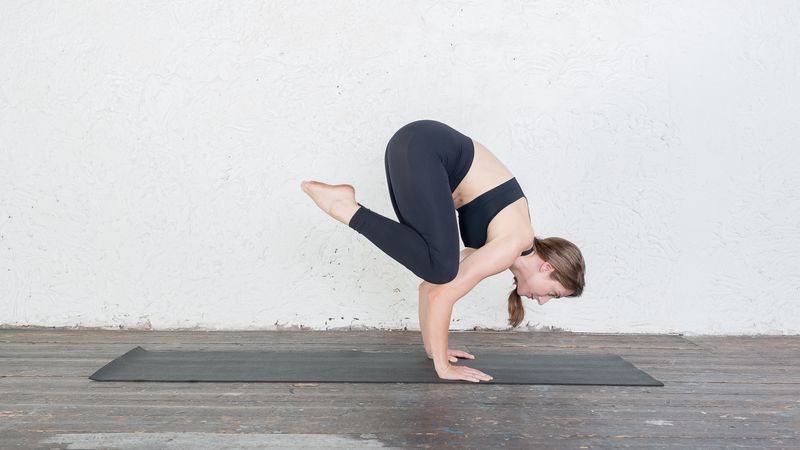
Kakasana, or Crow Pose, brings mental balance and focus while strengthening the wrists and arms. Regular practice of this yoga asana stimulates the Svadhishthana Chakra, increasing core awareness, removing fatigue, and improving the function of your urinary tract, kidneys, and reproductive system.
- Let’s begin by standing on your mat with your feet shoulder-width apart.
- Bend forward and allow your knees to bend too, placing them against your upper arms just above your elbows. Keep the connection between your arms and knees as you place your hands on the floor.
- Shift your weight onto your hands and lift your feet off the floor, one by one, pulling them up towards your hips.
- If you feel stable, press through your hands to straighten your arms as far as possible.
- Hold the pose as long as it is comfortable, breathing evenly. Remember to honor your body and make any necessary adjustments to find a comfortable and steady position.
Classical Triangle Pose (Trikonasana)
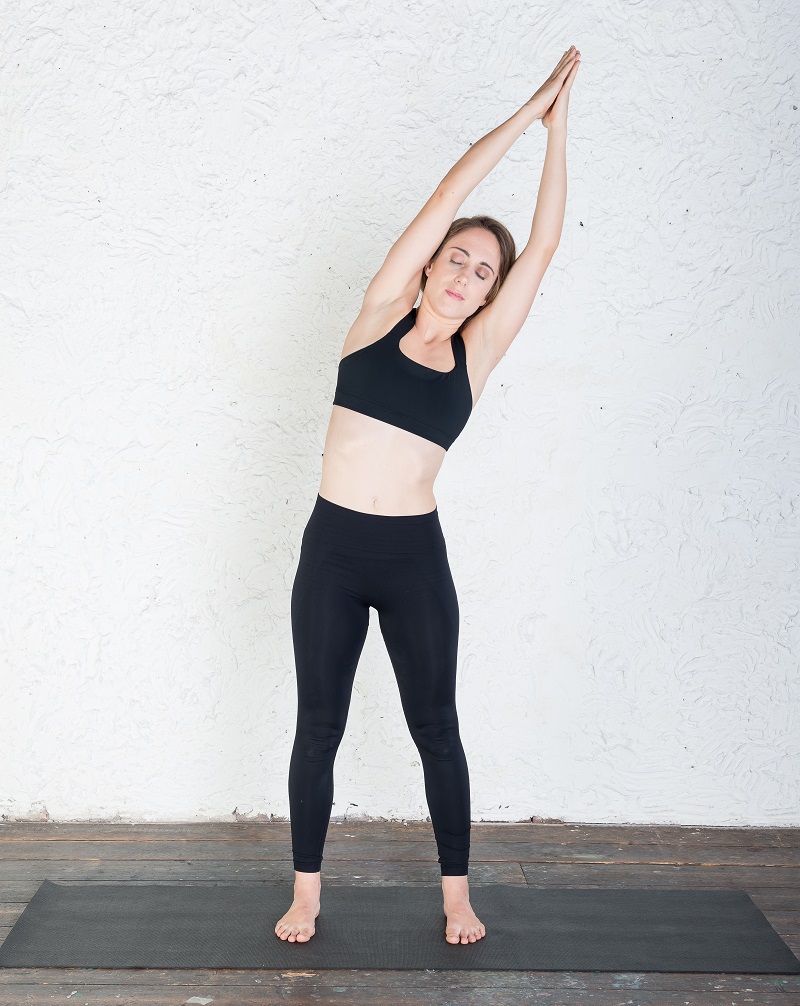
Classical Triangle Pose, also known as Trikonasana, balances the functions of your urinary tract, kidneys, and gonads. The gentle side body stretch also tones and strengthens your abdominals and back muscles and improves overall balance and concentration.
- Inhale and bring your arms up next to your ears, reaching upwards and lengthening your spine.
- Place your palms together, ensuring that your hands stay in a straight line above your forehead.
- As you exhale, press your right heel into the floor and reach up and out to your left side.
- Initiate the movement at the base of your spine and keep both sides of your torso elongated as you extend your entire torso to your left.
- Remember to breathe deeply and move mindfully, honoring your body’s needs and limitations.
Side Plank Pose (Vashishtasana)
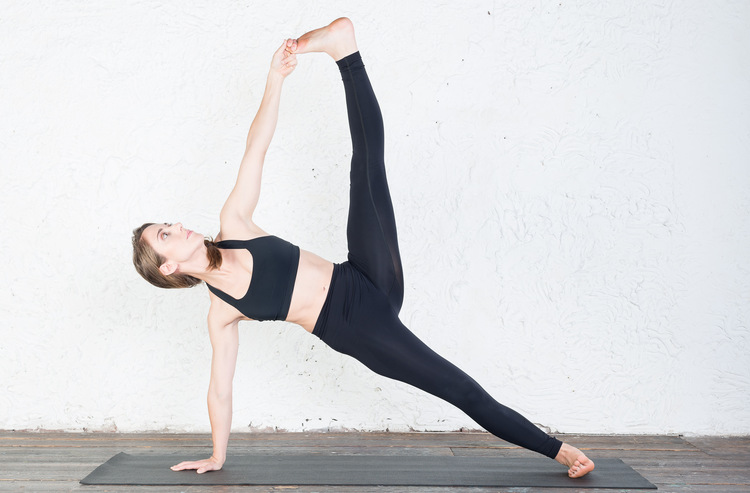
This yoga pose for the Sacral Chakra strengthens and tones the arms, core, and legs, while simultaneously channeling energy to your sacrum. For a wider opening in the hips and groin, you can extend the leg up toward the ceiling. Be cautious of your balance here as it can get a bit wobbly.
- Begin in a high plank position, with your wrists below your shoulders, legs straight, and feet together.
- Lift your left arm off the floor and rotate your body so that your left shoulder is above your right.
- Stack your left foot on top of your right, supporting the weight of your body on the outer right foot and right hand.
- Bend your left knee and draw your thigh towards your torso. Then, reach inside the bent leg and use the index and middle fingers of your top hand to grab your big toe.
- Remember to keep your core engaged, and your breath steady. Find a comfortable balance and enjoy the opening in your hip flexor and the stretch in your hamstring
- Hold onto something for support and lift your left leg straight up towards the ceiling.
- Focus on finding your balance, keep your gaze up towards the ceiling, and hold the pose as long as it’s comfortable, breathing evenly.
Standing Forward-Bend Pose (Uttanasana)
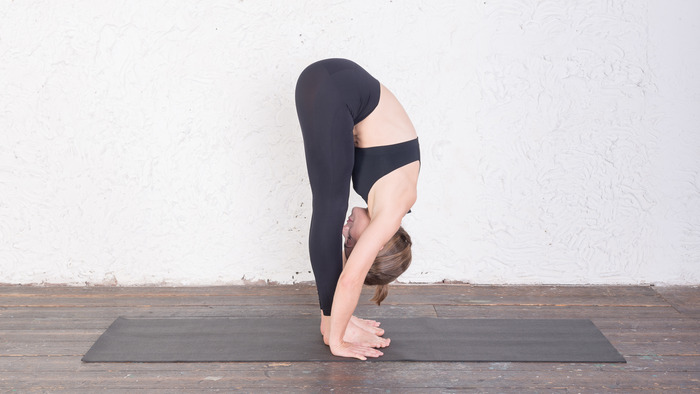
Standing Forward-Bend Pose provides a rejuvenating stretch for the hips, hamstrings, and calves while balancing the energy center. Relaxing your upper body, this forward fold also helps release tension in the back and neck with stress and anxiety-relieving benefits.
- Begin by standing on your mat, either with your feet together or hip-width apart.
- As you exhale, gently bend forward from your hip joints, allowing your upper body to fold forward.
- Keep your knees straight and bring your palms or fingertips to the floor, just in front of or beside your feet.
- With each inhalation, feel your front torso lifting and lengthening ever so slightly. And as you exhale, allow yourself to release a little more fully into the forward bend.
- To come our of this pose, bend your knees until your torso touches your thighs. Press your heels firmly into the floor and begin to roll your spine upward, vertebra by vertebra, until your shoulders and head come up last.
Handstand Pose (Adho Mukha Vrkshasana)
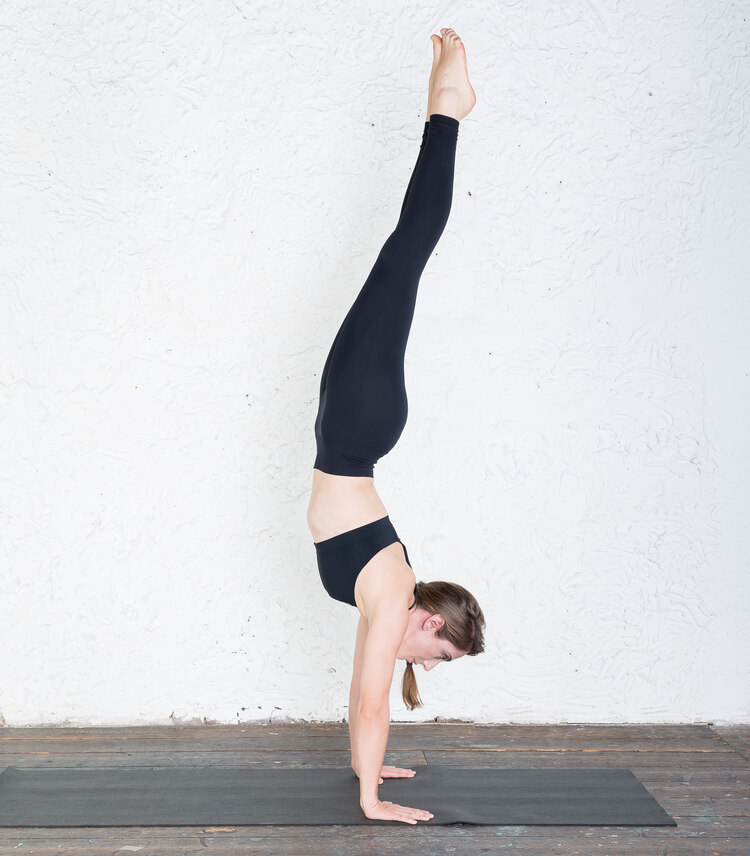
Handstand Pose is a powerful yoga pose that activates dormant energy in the sacrum and builds strength in the shoulders, back, and abdomen.
- Let’s start in Downward-Facing Dog Pose with your hands in line with your shoulders and actively pushing into the floor.
- Now, walk your feet inwards towards your chest, while keeping your arms straight and shoulder blades drawn away from your ears. Engage your core and suck in your navel towards your spine.
- Looking slightly forward, lift one leg up towards the ceiling and push off from the other leg. With a gentle hop, follow with that leg so that you are standing on your hands.
- Squeeze your inner thighs together, point your feet towards the ceiling, and focus on a point on the floor in front of you.
- Hold the pose for as long as comfortable, breathing evenly. To release the pose, bring one leg down with control at a time.
Connect with Water
The Sacral Chakra is associated with the water element and its natural flow. Connecting with water, such as a lake or river, helps promote balance here. Taking a shower or a warm bath can also regulate overwhelming emotions.
Conclusion
The Svadhishthana Chakra symbolizes creative potential, the ability to harbor fulfilling relationships, as well as our sexual energy. Suppressing such vital energy or obsessing over negative thoughts and patterns causes blockages that can harm your emotional and physical well-being. Whether practicing affirmations, yoga poses, or simply wading in a natural body of water, restoring balance to the second chakra is key to becoming a more empowered and confident individual.

Sign up for our newsletter and get exclusive access to a free guided meditation and lecture with master teacher Ram Jain.


